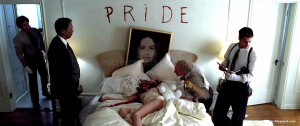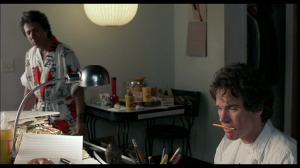From the October 6, 1995 Chicago Reader. — J.R.


Seven
*** (A must-see)
Directed by David Fincher
Written by Andrew Kevin Walker
With Morgan Freeman, Brad Pitt, Gwyneth Paltrow, Richard Roundtree, R. Lee Ermey, John McGinley, Julie Araskog, Mark Boone Junior, and Kevin Spacey.

Since when have designer vomit, mannerist rot, and other chic signifiers of gloom, doom, and decline become such comforting mainstays of movies? I’m thinking not only about Hollywood but about Western cinema generally. What brings on all the driving, dirty rain in Satantango (Bela Tarr’s seven-hour Hungarian black comedy, which showed at last year’s Chicago International Film Festival) as well as in Seven, a stylish and affecting (albeit gory) metaphysical serial-killer movie? The facile solution would be to trace the gloom back to Blade Runner, film noir, maybe even to Prague school surrealism, though this would omit the Calvinist/expressionist vision of urban filth and the post-Vietnam psychopathology of Taxi Driver. In point of fact, it’s much more important to figure out the reasons for the strange allure of this grim sensibility than to worry pedantically about where it came from.
I’d ascribe at least part of this taste to the current inability to believe in or try to effect political change — a form of paralysis that in America is related to an incapacity to accept that we’re no longer number one. Read more
From the Chicago Reader (October 14, 2011). — J.R.

It’s a fairly safe bet that “List-o-mania,” first published in June 25, 1998, was the most popular piece I published in the Reader during my 20 years there as film reviewer, roughly halfway through my stint there. I suspect its appeal had a lot to do with the growing popularity of movie lists ever since the video market started expanding the choices of most viewers.
Like a commercially successful Hollywood feature, “List-o-mania” had its share of sequels and spinoffs. Retitled “The AFI’s Contribution to Movie Hell,” it became a chapter in my most popular book, Movie Wars: How Hollywood and the Media Limit What Films We Can See (2000), a rant that received over a hundred reviews despite the fact that its small Chicago publisher (a cappella books, a division of Chicago Review Press) couldn’t afford much advertising, aside from freebies in the Reader, and I never even met my publicist there.
In the book, I added in a footnote a list of 25 titles in the AFI’s list that I probably would have included if I’d started my own list from scratch. Then, as an appendix to my 2004 collection Essential Cinema: On the Necessity of Film Canons (Johns Hopkins University Press), I compiled a chronological list of my 1000 favorite films, with asterisks next to my 100 crème de la crème, this time including shorts as well as features and non-American as well as American items—a list to which I added 60 more titles in my Afterword to the 2008 paperback. Read more
Based on feedback, I would guess that this article, which first appeared on June 25, 1998, is the most popular piece I ever published in the Chicago Reader. Although it’s been featured as a separate item for several years on their site, I noticed that, thanks to some of their recent user-unfriendly retoolings of that site — which makes it much harder to access anything and everything, including this article — my own list of my 100 favorite films at the end of this piece and the AFI’s list of the supposedly greatest 100 films somehow got scrambled together. [Update, 7/25/09: Checking back a day later, this now appears unscrambled.] This is mainly why I’ve decided to reprint the original piece here in Notes, with only a few minor modifications. I revised and expanded this piece still further in my book Movie Wars: How Hollywood and the Media Limit What Films We Can See, where it forms the sixth chapter. (I’m sorry that the English edition of this, which has a much better jacket, has become more scarce.) One of the main additions, on page 93, is a list of the 25 titles on the AFI list that I probably would have included on my own if I hadn’t wanted to create an all-new list for polemical purposes; six of these titles are illustrated at the tail-end of this piece. Read more




